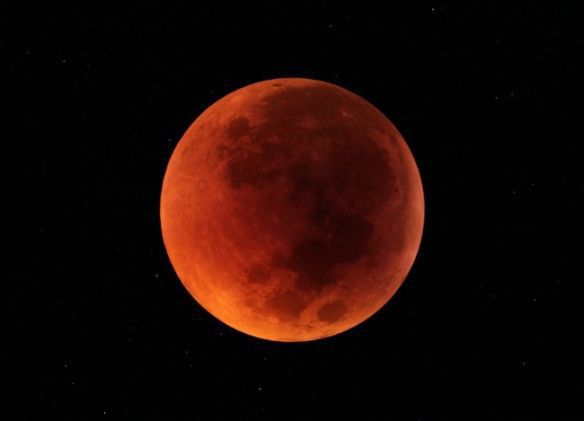
The Internet is rife with stories about a “super blue blood moon” that will appear on the morning of January 31. While these descriptors are scientifically dubious, they have become popular in the media and are also for the most part based on the actual orbital behavior of our nearest neighbor and hence worth explaining.
To start with, all these terms refer to a full moon, a lunar phase occurring when Earth lines up directly between the Moon and Sun. This means the latter two bodies are opposite each other in the sky; as the Sun rises in the East, for instance, the Moon sets in the West.
Since the Moon orbits Earth in a slightly elliptical path, the distance between the two bodies varies. When they reach their closest approach to each other—a point known as perigee—the Moon appears a bit larger and brighter than when it is farther away. Some years back, an astrologer started using the term “supermoon” to describe this close approach, though he never defined the precise distance. The word soon became popular and some astronomy experts have even tried establishing distance parameters (usually between 222,000 to 223,000 miles) but the word has no scientific value.
Then we have “blue moon.” The term goes back at least to the time of Shakespeare and was used as a reference to an obvious absurdity. To say “You’d claim that the Moon is blue” was like today saying “You’d argue that Earth is flat.” But this definition has no astronomical tie, just like the related use of blue moon that indicates refusal to do something: “I’ll vote for that candidate when the Moon is blue” was like saying “I’ll vote for that candidate when hell freezes over”.
Actually, the Moon does occasionally appear blue, the result of dust or smoke from large fires or volcanic eruptions on Earth. The dust and smoke particles scatter incoming light passing through them and, if the particles are of a certain size, will scatter blue light less than other colors, leaving an abundance of the blue light that give the moon a blue color. This occasional blue moon led to perhaps the most oft-used definition of a blue moon, referring to something that rarely happens: right now, for example, you might say that the Phoenix Suns win once in a blue moon.
In the past several decades, people have celebrated yet another definition of blue moon, which refers to the second full moon in any given month. The origins of this meaning were described in the astronomy magazine Sky & Telescope in 1946. The author cited the 1937 Maine Farmers Almanac as the source for this particular definition of blue moons. Unfortunately, the Sky & Telescope author misinterpreted the definition as given in the almanac, which was admittedly quite convoluted. In the almanac, “blue moon” apparently was used to describe the third full moon in a season which has four full moons (the year is broken up into four seasons, with three months in each season. In general, each month has a full moon, and thus there would be three full moons each season. Occasionally, though, a fourth full moon would occur.)
Thus, we have an astronomical definition of blue moon that was created by error, but stays with us. Plus, the seasons are much more accurately defined astronomically than the months, so it begs the question whether this definition is truly astronomical, though it will likely be thought of as such.
Much like the term supermoon, blood moon is another perverse term of recent origins. It is linked to total lunar eclipses, when the Moon passes through Earth’s shadow, but has multiple interpretations. The first refers to a tetrad of lunar eclipses, meaning four consecutive eclipses that are all total. Some people have read religious meaning into this sequence, seeing the tetrad as some sort of prophecy. They thus gave a special name to these eclipses, calling them blood moons.
The last lunar tetrad occurred in the years 2014-2015 (as luck would have it, the world didn’t end despite the appearance of these blood moons). The next will be in 2032-2033. So why are some stories in the media calling the January 31 eclipse a blood moon? Because of the second, less common, interpretation of the term blood moon. During a total lunar eclipse, sunlight that is refracted, or bent, around Earth and onto the Moon will give the Moon an orange or red color. Some people thus call any total lunar eclipse a blood moon.
So here we have a bunch of suspect terms with which we now seem stuck. On the bright side, we can look forward to the total lunar eclipse on January 31. It will be visible from much of North America, as well as northeastern Europe, Russia, Asia and Australia. In Flagstaff we will see it during early morning hours. The partial phase will start at 3:51 a.m., with the Moon in the western part of the sky. Totality begins at 5:51 a.m. and ends at 7:07 a.m. The Moon will still be partially eclipsed when it sets at 7:29 a.m., bringing an end to the super blue blood moon.

